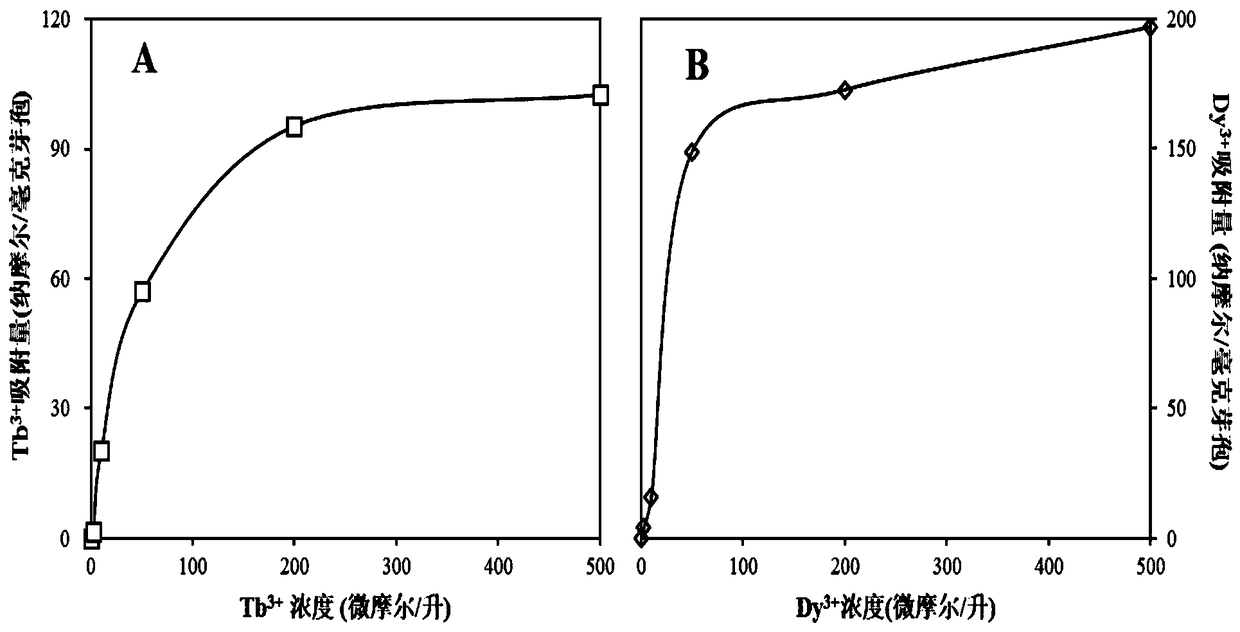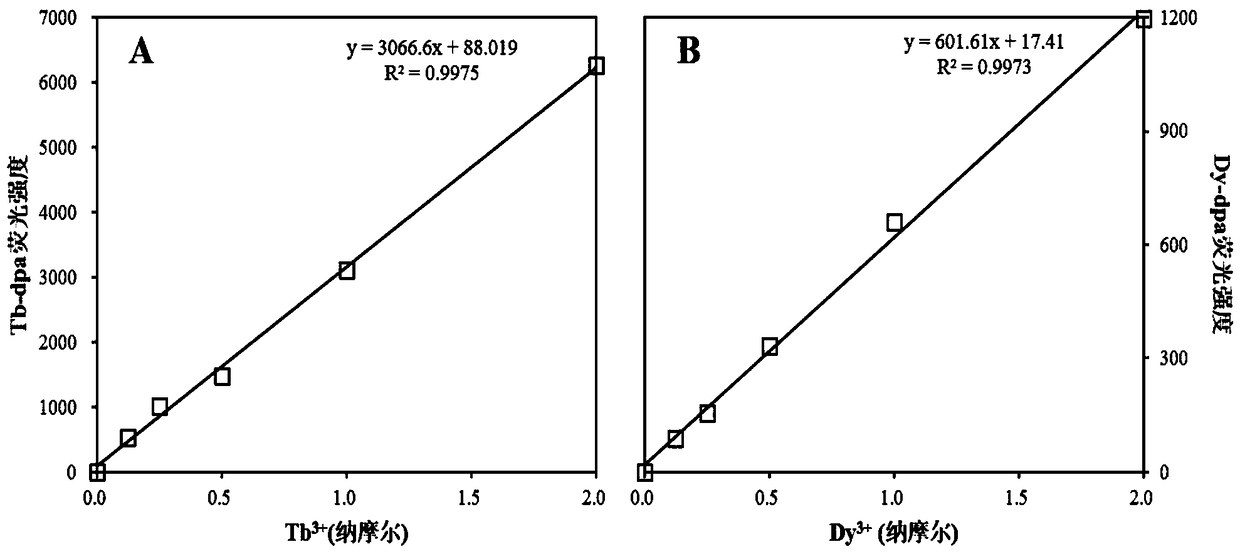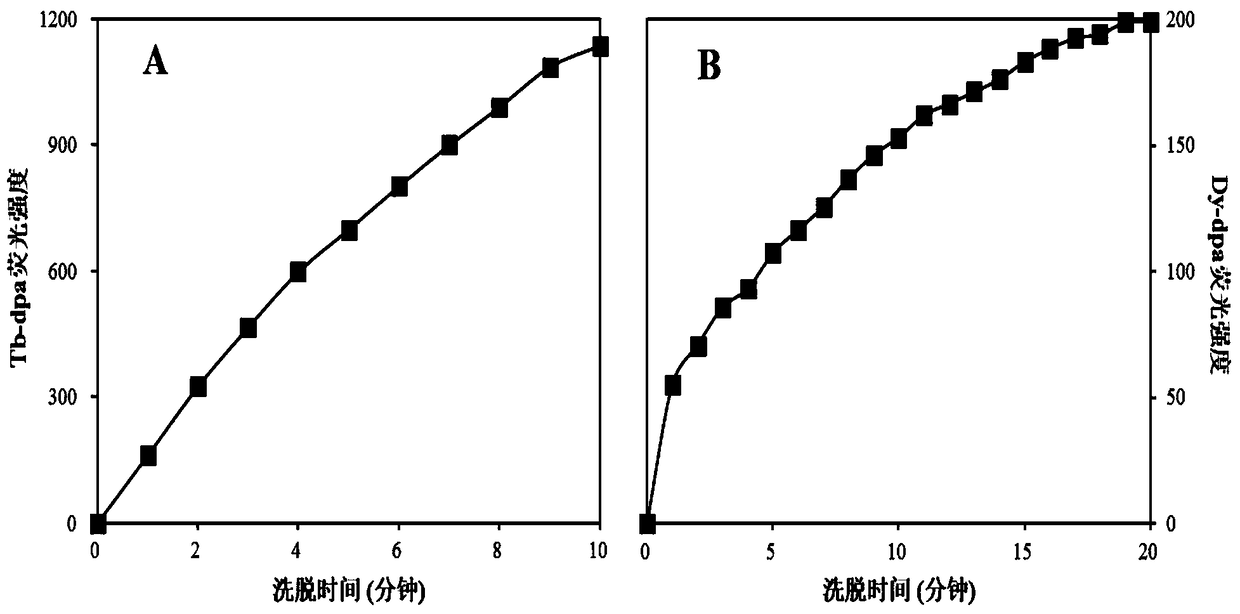Method for recycling rare earth ions by using bacillus subtilis spores
A Bacillus subtilis, rare earth ion technology, which is applied in the methods of using spores, microorganism-based methods, biochemical equipment and methods, etc., can solve the problems such as the recovery of rare earth ions from Bacillus subtilis that have not yet been found, and achieve the effect of easy detection and recovery. Evaluate and avoid the use of reagents such as large amounts of acids and bases, the effect of reducing the risk of environmental pollution
- Summary
- Abstract
- Description
- Claims
- Application Information
AI Technical Summary
Problems solved by technology
Method used
Image
Examples
Embodiment 1
[0034] Example 1 Preparation and collection of Bacillus subtilis 168 spores
[0035] The preparation and collection of Bacillus subtilis 168 spores include the following steps:
[0036] 1) After the activated Bacillus subtilis strain was inserted into LB liquid medium for 4 hours at 37°C and 250rpm shaker culture, the seed liquid was transferred to 2x SG solid culture based on 37°C for 5 days; the Bacillus subtilis strain Activation includes the following steps: Streak the preserved Bacillus subtilis strains onto LB solid medium, and culture overnight in a 37°C incubator;
[0037]2) Collect the spores obtained in step 1) into a centrifuge tube, add sterile deionized water at 4°C, oscillate and ultrasonicate for 4 minutes, then centrifuge at 10,000 rpm for 15 minutes at 4°C, remove the supernatant, and add 20% by mass of iodine Suspend the cells in hexanol solution, shake and then transfer to 50% by weight iohexol solution, centrifuge at 10000rpm for 15min at 4°C, remove the s...
Embodiment 2
[0038] Example 2 Adsorption detection of Bacillus subtilis 168 spores
[0039] The spores prepared in Example 1 were incubated with solutions containing different concentrations of rare earth ions at pH 7.2 for 10 minutes at room temperature, centrifuged at 14000 rpm for 4 minutes, the supernatant was removed, and the adsorbed spores were collected. Spore to Tb 3+ 、Dy 3+ The detection diagram of the adsorption effect is as follows figure 1 As shown, the surface of the spores was fully cleaned before the detection, so that the rare earth ions with weak binding force on the surface of the spores were washed away, and the 3+ The saturated adsorption capacity is about 102 nanomoles / mg spore, and the spore is to Tb 3+ The saturated adsorption capacity is about 196 nmol / mg spore. The adsorption capacity of spores to different rare earth ions is not the same, and the detection of saturated adsorption capacity in the present invention eliminates the adsorption effect of weak surfa...
Embodiment 3
[0041] Example 3 The method of recovering rare earth ions by using Bacillus subtilis spores
[0042] A method utilizing bacillus subtilis spores to reclaim rare earth ions, comprising the steps of:
[0043] 1) Preparation and collection of spores: as in Example 1;
[0044] 2) adsorption of spores: as in embodiment two;
[0045] 3) Elution of spores and recovery of rare earth ions: the spores obtained in step 2) were eluted by adding excess 2,6-pyridinedicarboxylic acid under the condition of maintaining pH 7.2, and the supernatant was collected by centrifugation at 12000 rpm for 4 minutes to obtain A recovery solution containing rare earth ions, the recovery solution is detected by fluorescence to obtain the content of rare earth ions.
[0046] When the rare earth ion is Tb 3+ When, Tb 3+ The fluorescence intensity detection picture of the complex formed after binding with excess DPA is as follows figure 2 As shown in A, the absorption spectrum of fluorescence detection ...
PUM
| Property | Measurement | Unit |
|---|---|---|
| purity | aaaaa | aaaaa |
| adsorption capacity | aaaaa | aaaaa |
| adsorption capacity | aaaaa | aaaaa |
Abstract
Description
Claims
Application Information
 Login to View More
Login to View More - R&D
- Intellectual Property
- Life Sciences
- Materials
- Tech Scout
- Unparalleled Data Quality
- Higher Quality Content
- 60% Fewer Hallucinations
Browse by: Latest US Patents, China's latest patents, Technical Efficacy Thesaurus, Application Domain, Technology Topic, Popular Technical Reports.
© 2025 PatSnap. All rights reserved.Legal|Privacy policy|Modern Slavery Act Transparency Statement|Sitemap|About US| Contact US: help@patsnap.com



